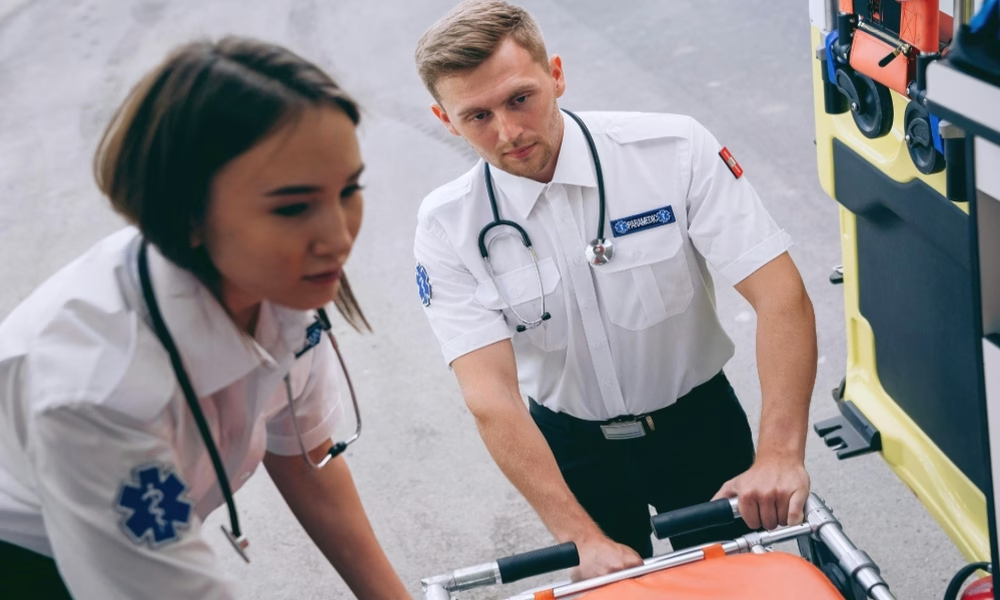
Texas has a response problem. In its more rural counties, some emergency medical services (EMS) teams are driving 50 miles or more just to reach a call, with minimal backup and limited resources. But response times are not just a matter of dispatch logistics. It’s about personnel. Or rather, the lack of them.
So what’s fixing it?
Online EMT and paramedic training programs (paired with local fieldwork placements) are doing what conventional classroom education couldn’t. They’re producing more ready-to-deploy professionals without pulling them away from the communities that need them most.
The Problem with Traditional EMS Education
For decades, EMS training in Texas followed the same model: attend classes at urban-based institutions, clock hours in simulation labs, and commute for clinicals. This worked well enough in cities like Dallas or Houston. But for aspiring paramedics in Alpine or Crockett, it meant leaving town for months.
That model wasn’t just inconvenient. It was creating a shortage.
Small towns were seeing their few candidates vanish into larger systems or abandon the career path altogether due to logistical or financial burdens. Programs based in distant cities weren’t flexible. And tuition costs, fuel, housing (stacked on top of unpaid training hours) weren’t realistic for a working adult or someone raising a family.
Now, things are shifting. Technology didn’t just digitize training. It localized it.
Online Learning, Local Impact
Texas EMS agencies began partnering with accredited online course providers around 2020. These platforms offer everything from EMT-Basic to Advanced Paramedic content in fully digital formats. And they’re not watered down. These courses still meet National Registry of Emergency Medical Technicians (NREMT) standards.
Here’s where the model works: learners study the theory at home, on their own schedule, using mobile-friendly content, quizzes, and video lectures. Then, for practical training, they’re placed with local EMS services or fire departments to complete hands-on requirements.
This means someone in a town like Marfa doesn’t need to uproot their life to become a paramedic. They can learn online, complete clinical ride-alongs at their local fire station, and join the very team that trained them.
It’s a model that’s scaling fast, as reports from the Texas Department of State Health Services show that rural EMS recruitment improved significantly in counties with hybrid EMT training programs.
Crossroads of Health Professions & Bridging Disciplines Online
This rise in online EMS training mirrors a broader trend across healthcare. Nursing, especially in mental health, is seeing similar transformation. Consider the online psychiatric nurse practitioner degree programs now available through institutions like Rockhurst University. These programs allow RNs to train for advanced psychiatric roles while staying in their home communities—critical for rural areas where mental health services are nearly nonexistent.
By integrating asynchronous coursework with clinical partnerships, these online psychiatric nurse practitioner degree programs are solving the same distribution challenge EMS education faces: too few professionals, too far from the populations that need them.
The success of these programs is not isolated. They signal a structural change in how healthcare education is delivered. Learning is becoming embedded in the very communities that will benefit from the graduates. And that’s more efficient AND more sustainable.
Scalability and Tech-Driven Upskilling
These programs are creating entry-level EMTs and upskilling existing personnel as well. Firefighters, police officers, and even volunteer responders are enrolling in advanced modules to become Intermediate or Paramedic-level certified, all without interrupting their work shifts.
Here’s what they’re gaining:
- Faster access to ALS (Advanced Life Support) protocols
- Improved collaboration across emergency teams in mass-casualty or disaster scenarios
With interactive simulations, scenario-based video cases, and AI-driven feedback mechanisms, online platforms are offering training that’s often more dynamic than a physical classroom.
And the flexibility goes beyond hours. Some platforms offer bilingual modules and accessibility accommodations, expanding the pipeline of future medics in underserved Hispanic and disabled communities.
The Remaining Gaps
Not every EMS director is on board. Concerns about quality control, certification consistency, and mentorship limitations still linger. Some argue that field placement variability can result in uneven skill acquisition.
But regulation is catching up. Texas has introduced stricter clinical documentation standards and increased oversight of online course providers. Meanwhile, local EMS supervisors are embedding mentorship and peer review into field placements to ensure consistent learning outcomes.
What the Future Lay of the Land Holds
Texas is solving a logistics puzzle that used to seem unsolvable. With over 60% of the state’s land classified as rural, getting qualified personnel on the ground was a bottleneck for years. Online training (paired with localized practical experience) is breaking that bottleneck open.
More counties are beginning to fund their own training cohorts. Others are lobbying for state subsidies to offset online program fees, which, while lower than traditional tuition, can still pose a barrier.
If replicated with enough consistency and oversight, this model could close the EMS shortage gap statewide.
And it’s not just about emergency services. With the success of initiatives like the online psychiatric nurse practitioner degree programs, Texas is showing how digital education can bring real-world care where it’s needed most—without delay, without relocation, and without compromise.
What used to be a profession that required big city access is becoming a homegrown solution, driven by smart technology and local trust. Emergency care in Texas is both reacting faster AND being redefined from the ground up.




